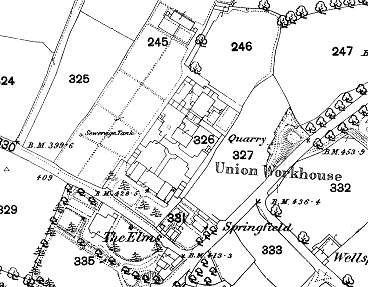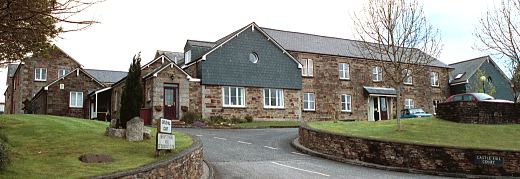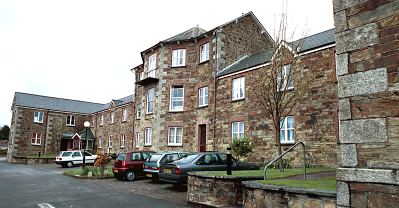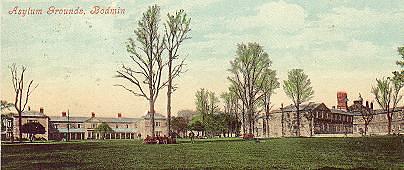Bodmin, Cornwall
Up to 1834
A large work-house was built at Bodmin in 1756 "on some of the Friery lands now belonging to the corporation, at the expence of Sir William Irby, bart., afterwards Lord Bolton." (Lysons, 1814)
A parliamentary report of 1777 recorded parish workhouses in operation at Bodmin for up to 70 inmates, and at Blisland for 4 inmates.
In 1804, prison reformer James Neild visited the Bodmin workhouse. He later recorded:
After 1834
Bodmin Poor Law Union was formed on 10th May 1837. Its operation was overseen by an elected Board of Guardians, 36 in number, representing its 21 constituent parishes as listed below (figures in brackets indicate numbers of Guardians if more than one):
Cornwall:
Blisland, Bodmin — Parish, Bodmin — Borough (4), Cardingham (2), Endellion (2), Egloshayle (2), Helland, St Kew (2), Lanhydrock, Lanhivet (2), Lanlivery (3), Lostwithiel (2), Luxulion (2), Saint Minver Highlands (2), Saint Minver Lowlands, Saint Mabyn (2), Temple, Saint Tudy, Warleggon, Withiel, Saint Winnow (2).
Later Additions: Wadebridge (1898).
The population falling within the Union at the 1831 census had been 18,836 with parishes ranging in size from Temple (population 29) to Bodmin Borough (3,375). The average annual poor-rate expenditure for the period 1834-36 had been £6,660 or 7s.1d. per head of the population.
The Bodmin Union workhouse was built in 1838-42 to designs by William Dwelly and was intended to accommodate up to 250 inmates. It was erected at a cost of around £5,000 on an elevated site at the north of Bodmin. Its location and layout are shown on the 1881 map below:

Bodmin site, 1881.
At the south was a two-storey front block.

Bodmin front block from the south-west, 2001.
© Peter Higginbotham.
To the rear was an H-shaped main block, of two-storeys for the most part, but with an octagonal three-storey hub.

Bodmin from the south-east, 2001.
© Peter Higginbotham.
A further block to the north included an infirmary accompanied by various outbuildings. A small isolation hospital was erected to the north-west.
The Bodmin Boards of Guardians appear to have made use of the Lostwithiel House of Mercy for at least some of its orphan children. The minute books of the Guardians' meeting for 10th May, 1879, note that 'Emily Pedlar, aged 4, to be sent to the House of Mercy at Lostwithiel and be allowed £1 for clothes and 2/- a week for maintenance'. The decision clearly raised an eyebrow with the central poor law authority — two weeks later, at their meeting on 24th May, the Guardians agreed, in relation to E. Pedlar, that the Clerk was to reply to the Local Government letter and 'state that the House of Mercy at Lostwithiel is not a hospital for treatment of cripples but that the object of sending her there is to have her cared for'. Whatever the objection had been, it now seems to have been resolved. The minutes of the Board meeting on June 21st note that following a letter 'from the Local Government Board, E. Pedlar should be sent to House of Mercy without delay'. In 1882, the House of Mercy was formally accredited as a Certified School allowing it to receive, as a matter of course, children boarded out by Boards of Guardians.
In September 1895, soon after the workhouse had been connected to the mains water supply, members of the town fire brigade gave the board of guardians a demonstration of how any fire could now be dealt with. A discussion followed concerning a letter from the Local Government Board, asking whether provision for inmates escaping in the case of fire had been made in accordance with a recent inspection report. The Board resolved to reply that certain internal rearrangements, coupled with the new water supply, made any further provision unnecessary. A resolution to purchase a 'jumping sheet' was lost by a large majority.
After 1930, the workhouse was taken over by the Cornwall County Council and became a Public Assistance Institution known as Berry Tower House.
By the 1960s, the front block had become a works and the main building a depository.
The surviving former workhouse buildings have been converted into residential accommodation. The former isolation hospital is now a private house.
Bodmin Union Children's Homes
In 1913, the Bodmin Union spent £550 on the erection of a home for 12 destitute girls at 17 Beacon Road (number 22 now occupies the site following renumbering). Another house, for 14 destitute boys, was taken on Berrycombe Hill.
Bodmin Asylum
Bodmin was also the home of the Cornwall County Lunatic Asylum, later St Lawrence's Hospital.

Cornwall County Lunatic Asylum, Bodmin.
© Peter Higginbotham.
Staff
Inmates
Records
Note: many repositories impose a closure period of up to 100 years for records identifying individuals. Before travelling a long distance, always check that the records you want to consult will be available.
- Cornwall Archives, Kresen Kernow, Little Vauxhall, Redruth TR15 1AS. Relatively few records survive — holdings include Guardians' minute books (1842-4, 1877-81, 1884-7, 1896-1930); etc.
Bibliography
- Lysons, Samuel (1814) Magna Britannica, volume 3.
- Philip, Tony (2005) A Social History of Bodmin Union Workhouse (Bodmin, Cornwall: Bodmin Town Museum)
Links
- None.
Unless otherwise indicated, this page () is copyright Peter Higginbotham. Contents may not be reproduced without permission.


